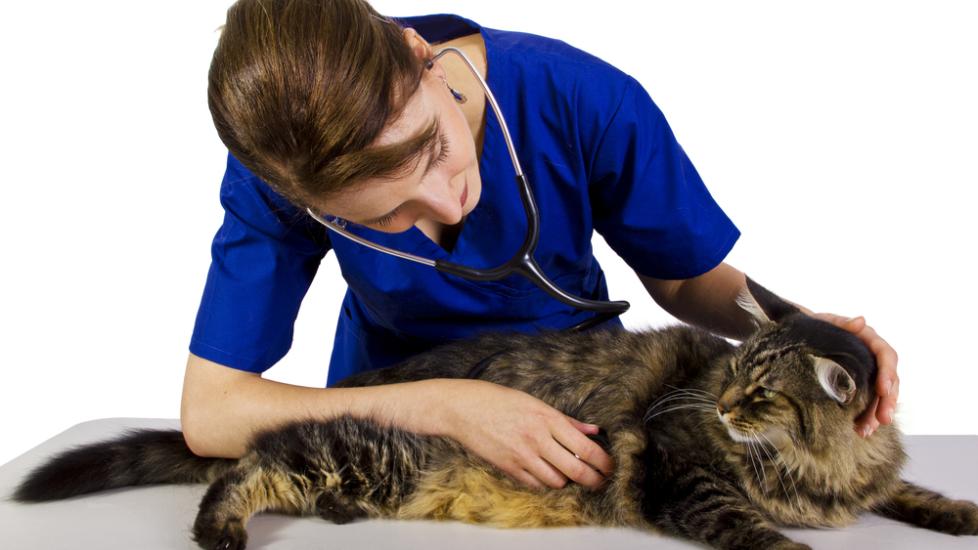Enlarged Liver in Cats
Hepatomegaly in Cats
Due to certain diseases and conditions that can either directly or indirectly affect the liver's ability to function, the organ may increase in size, which is referred to as hepatomegaly.
Symptoms and Types
Kittens normally have larger livers in regard to their actual body mass, as compared to adult cats. However, hepatomegaly is most commonly diagnosed in older cats. Depending on the underlying cause, the enlargement may involve the whole liver or only part of the liver. For example, infections and/or inflammation may lead to a generalized symmetrical enlargement of the liver, whereas tumors, hemorrhages, cysts, or rotation of the liver lobe may lead to asymmetrical or focal enlargement. That is, only a part of the liver may be enlarged.
Symptoms can vary depending on the cause. Enlargement of the abdomen is the most commonly observed symptom. On examination your veterinarian will find an enlarged liver or a palpable mass in the abdominal area. The mass is usually observed behind the rib cage and may even be visible with naked eye. However, in obese animals it is difficult to detect an enlarged liver on physical examination.
Causes
- Extra blood pooling near the liver
- Hepatitis (liver infection)
- Chronic liver disease (cirrhosis)
- Obstruction in blood flow passing through the liver
- Heart disease and failure
- Liver neoplasia
- Heartworm disease
- Rotation of the liver lobe around its axis
- Diaphragmatic hernia (hernia resulting from the protrusion of part of the stomach through the diaphragm)
- Abnormal deposition of metabolic products within the liver tissue
- Accumulation of fat in the liver tissue
- Tumor involving the pancreas
- Liver abscess
- Liver cyst
- Drug toxicity
Diagnosis
You will need to give a detailed history of your cat’s health, onset and nature of symptoms, and possible incidents that might have led to this condition. Your veterinarian will perform a thorough physical exam to evaluate all body systems, and a complete blood profile will be conducted, including a chemical blood profile, a complete blood count, and a urinalysis. The results of the routine laboratory tests are highly variable depending on the underlying cause of the liver enlargement. The complete blood count may reveal anemia, abnormal spherical red blood cells (spherocytes), disrupted red blood cells (schistocytes), red blood cells with spots due to hemoglobin accumulation (Heinz bodies), presence of parasites with red blood cells, immature white blood cells (blast cells) in the blood, red blood cells with nucleus, and abnormally low or high number of platelets (tiny cells used in blood clotting). The biochemistry profile may show abnormally high levels of liver enzymes, and a high cholesterol level. Further testing may include blood clotting profile as blood clotting abnormalities are common in patients with liver involvement. Your cat may also be tested for presence of heartworm disease.
The abdominal X-rays may show an enlarged liver with rounded margins, or a displaced stomach and kidneys. The chest X-rays may help in determining any metastasis of a tumor to the chest cavity, and will also show diseases involving the heart and lungs. Abdominal ultrasonography can be used to view further details in the abdominal cavity, revealing changes in liver size and surface contour, as well as the presence of concurrent diseases. Abdominal ultrasound will also help in discriminating diffuse or localized types of liver enlargement. More advanced diagnostic tests, like electrocardiography and echocardiography, can be used to evaluate the structure and functions of heart.
If tumors are seen or suspected, your veterinarian will want to take a sample of liver tissue in order to confirm either its benign or malignant nature, but even without a tumor present, a tissue sample can be helpful for determining the cause, severity and stage of the liver disease. The samples will be sent to laboratory for microbial cultures, and in case of infection, the culturing of the sample will help in determining the type of microorganism that is involved so that suitable drugs can be prescribed.
Treatment
Treatment is highly variable and will depend on the underlying cause. In case of heart involvement or advanced liver disease, your cat may need to be hospitalized for intensive treatment and supportive care. The aim of treatment is eliminate the inciting cause and prevent further complications. Broad spectrum antibiotics are given to the patients with infections. Dehydration is common in these patients and intravenous fluids are required for normalizing the fluid levels. Multivitamins are also given to maintain the healthy levels of vitamins. Some patients may also require surgical interventions to remove a tumor, abscess, or cyst.
Living and Management
Patients with heart failure or excessive fluid in the abdomen require changes in feed and fluid intake. These patients need special care and often complete cage rest is recommended. Special diet considerations, like addition of high levels of proteins, restriction of salt, and adequate vitamin supplementation will be put in place for your cat.
The prognosis is variable and depends on the underlying cause and duration of the disease. Some causes are less serious, while others are life-threatening in nature. As the liver is the central organ in the metabolism of drugs, you must not give any drug or change the dosage amount of any prescribed drugs without prior consultation with your veterinarian. In order to prevent negative energy balance, you will need to feed small and frequent meals to your cat. Your cat will need to be evaluated frequently during therapy. Your veterinarian will conduct laboratory testing and radiography as necessary to monitor your cat's progress.
